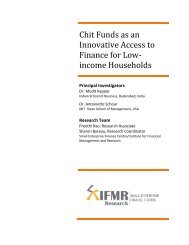Government of India Volume I: Analysis and Recommendations
Government of India Volume I: Analysis and Recommendations
Government of India Volume I: Analysis and Recommendations
Create successful ePaper yourself
Turn your PDF publications into a flip-book with our unique Google optimized e-Paper software.
MICRO-PRUDENTIAL REGULATION<br />
cannot be designed with extreme examples in mind. Regulations framed from the perspective<br />
<strong>of</strong> malign institutions could lead to over-regulation just as the same framed with<br />
only the most benign institutions in mind could lead to under-regulation.<br />
Regulators will also need to take into account the possibility <strong>of</strong> developing robust<br />
models, given data sufficiency constraints. Faulty modelling is a possible consequence<br />
<strong>of</strong> poor data, drawn from illiquid or opaque markets. As such, the draft Code authorises<br />
the regulator to consider alternative pathways <strong>and</strong>/or impose overall or risk-weighted<br />
capital requirements.<br />
The micro-prudential provisions in the draft Code will ask regulators to confront the<br />
trade<strong>of</strong>fs, <strong>and</strong> make wise decisions about the optimal regulation that is reasonably feasible<br />
for regulated persons to implement, <strong>and</strong> for the Regulator to monitor <strong>and</strong> supervise.<br />
Over the years, accumulation <strong>of</strong> datasets <strong>and</strong> academic research will give feedback about<br />
how certain initiatives have worked. Over the years, the financial system itself will evolve.<br />
The combination <strong>of</strong> these factors will give a healthy evolution <strong>of</strong> the appropriate trade<strong>of</strong>fs.<br />
PRINCIPLE 3. The need to minimise inconsistencies in the regulatory approach towards<br />
regulated activities that are similar in nature or pose similar risks to the fulfilment <strong>of</strong> the<br />
Regulator’s objectives under this Act.<br />
In the financial system, there are many ways <strong>of</strong> achieving the same objective. Products<br />
looking very different can be constructed that essentially fulfil the same function.<br />
The only difference would be the way these products look, <strong>and</strong> the specific contracts they<br />
comprise <strong>of</strong>. As an example, consider the number <strong>of</strong> ways <strong>of</strong> taking a levered position in<br />
shares <strong>of</strong> companies in the index, all <strong>of</strong> which fulfil the same function:<br />
1. Buy each stock individually on margin in the cash stock market.<br />
2. Invest in an index fund <strong>and</strong> borrow from a bank to finance it.<br />
3. Go long a future contracts on the index futures.<br />
4. Go long an over-the-counter forward contract on the index.<br />
5. Enter into a swap contract to receive the total return on the index <strong>and</strong> pay a fixed interest rate.<br />
6. Go long exchange-traded calls <strong>and</strong> short puts on the index.<br />
7. Go long Over The Counter (OTC) calls <strong>and</strong> short puts.<br />
8. Purchase an equity-linked note that pays based on returns on the index, <strong>and</strong> finance it by a repo.<br />
9. Purchase, from a bank, a certificate <strong>of</strong> deposit with its payments linked to returns on the index.<br />
10. Borrow to buy a variable-rate annuity contract that has its return linked to the index.<br />
Since these are functionally equivalent, each <strong>of</strong> these mechanisms would add the<br />
same risk to the regulated person. Regulators need not treat this diverse array <strong>of</strong> possibilities<br />
with a sense <strong>of</strong> alarm, neither should they be blind to these possibilities. The choice<br />
<strong>of</strong> a certain mechanism for fulfilling a function may depend on various factors, such as<br />
differences in financial systems, constraints imposed by institutional form, technological<br />
constraints, various types <strong>of</strong> transaction costs, <strong>and</strong> so on. An institution should be<br />
able to choose the best possible mechanism, given all the factors it chooses to consider.<br />
However, with a healthy financial regulatory structure, differences in micro-prudential<br />
regulation should not favour any one <strong>of</strong> these mechanisms over another.<br />
If the regulators take a functional perspective towards risk, treating similar risks in<br />
a similar manner, it would help reduce regulatory inconsistencies across products <strong>and</strong><br />
markets. This principle is likely to lead to efficient regulation, because it allows innovation<br />
<strong>and</strong> encourage competitive neutrality. It is also necessary because as system evolves<br />
<strong>and</strong> opportunities to earn supernormal returns become difficult to find, regulatory arbitrage<br />
could be used to destabilise the system. Capital will flow towards sectors with less<br />
expensive regulations <strong>and</strong> this can <strong>of</strong>ten involve inappropriate risk-taking.<br />
64 FINANCIAL SECTOR LEGISLATIVE REFORMS COMMISSION



